|

|
Wolverhampton's Blue
Plaques
Old Hall Street,
Garrick Street & St. George's Parade
|
 |
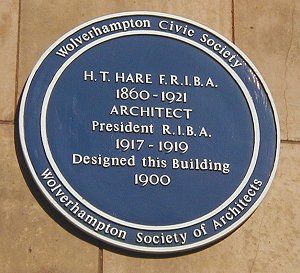 |
Commemorating:
H. T. Hare, architect.
Sponsored by:
Wolverhampton Society of Architects.
Location:
Central Library, Snow Hill.

|
| The plaque on the front of the library, which was
completed in 1902 and built by Henry Willcock & Co. of
Wolverhampton. |
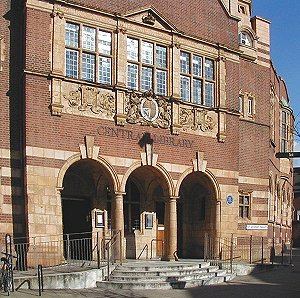 |
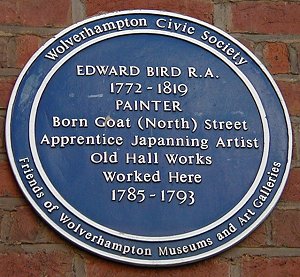 |
Commemorating:
Edward Bird, painter.
Sponsored by:
Friends of the Woverhampton Museums and
Art Galleries.
Location:
On the side of the Central Library in
Old Hall Street.
|
| The plaque on the side of the Central Library on
the corner of Old Hall Street and Garrick Street. |
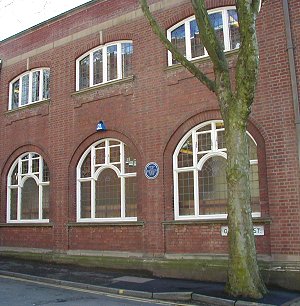 |
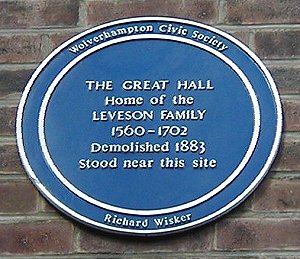 |
Commemorating:
The Leveson Family's Great Hall.
Sponsored by:
Richard Wisker
Location:
On the front of the Adult Education
Centre in Old Hall Street.
|
| The Leveson family were wool merchants who were
extremely successful in the local wool trade. They started their
business in about 1430 and in the early 16th century James
Leveson became the largest landholder in the area. James lived
at High Hall which was on the south side of the market square or
Queen Square as it is now known. In 1560 the family built, or
possibly rebuilt the Great Hall for their new home.
It was a moated Elizabethan manor house and was situated on the site of
the present Adult Education Centre. By the early 19th century,
the Great Hall, or Old Hall as it was then called had become a
japanning factory. It was demolished in 1883. |
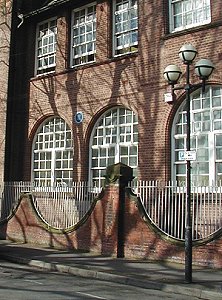 |
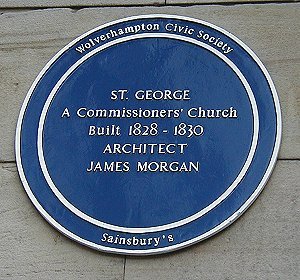 |
Commemorating:
St. George's Church.
Sponsored by:
J. Sainsbury P.L.C.
Location:
Entrance to Sainsbury's supermarket in St. George's Parade.
For more information on James Morgan visit the London Canal
Museum's website at:
http://www.canalmuseum.org.uk/
|
| Work on the church started in 1828, but there is
some doubt as to the true identity of the architect. It is
thought that the architect was probably James Morgan who was a
Welshman and an assistant, and later a partner of the famous
John Nash. The church was built of brick and encased in Tixall
stone. The design incorporated a west tower, a nave with north
and south aisles and a short chancel. The tower and spire bear
some remarkable similarities in detail to Nash's work at All
Souls in Langham Place. The building cost approximately £10,000
and was consecrated on 26th August 1830. |
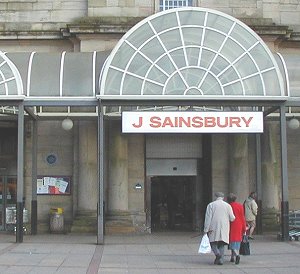 |
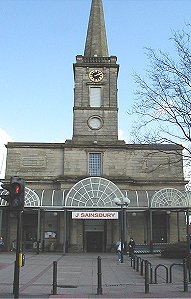 |
The church has had a chequered history. In 1849
the churchyard had to accommodate the many victims of the 1849
cholera epidemic. The victim's bodies were piled into mass
graves which soon covered much of the churchyard. It was closed
for burial in 1851, and after closure it was stated that because
no records were kept of the early burials the sexton had used a
borer to find empty spaces. In 1898 the burial ground was
landscaped as public gardens. In the 1970's there were only a
handful of parishioners and the church closed in 1978. After
many years of dereliction the church and grounds were purchased
by Sainsbury's and became a supermarket. The store opened in
January 1988. |
|